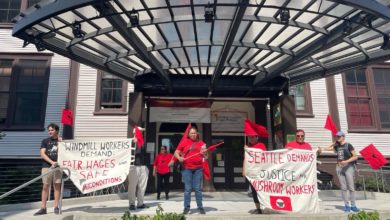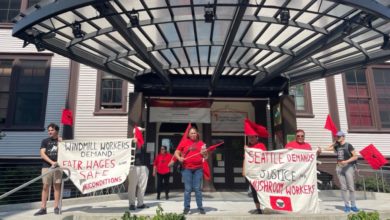On November 2, 2015 Ed Murray, the now-former mayor of Seattle, declared a “Civil Emergency on Homelessness” in Seattle. This was in response to the homeless population growing by 21 percent between 2014 and 2015 in addition to the death of 45 homeless people in Seattle in 2015. At that time the city decided to invest “an additional $5.3 million into homeless prevention and crisis services, funded by the sale of an underused city property.”(Seattle Weekly)
Since then King County Assessor John Wilson has determined that there is enough unused land in Seattle to provide housing for an additional 1,000 people. He has cataloged more than 300 spaces larger than 20,000 square feet located within ¼ mile of transit. All of these properties are currently owned by local government agencies including the City of Seattle, King County, the State of Washington, University of Washington, Washington State University, the Port of Seattle and Sound Transit. (Crosscut)
Some of these parcels are unusable due to toxic contamination or being located on the side of a very steep hill for instance. However, for the rest of the parcels, there remain two seemingly insurmountable hurdles that are solely due to laws and regulations, not physical barriers.
What’s preventing construction of low-cost and transitional housing on these sites?
First: municipal zoning laws restrict where and what kind of structure can be constructed. Every new effort to construct a refuge for homeless people must be announced with an “Intent of Land Use” notice and a public hearing. It is extremely difficult to get existing homeowners, merchants and developers to agree to transitional housing or even “low income” housing construction in their neighborhood. “There goes the neighborhood!” is the cliché that underscores this petty-bourgeois concern. Meanwhile, moneyed interests almost always win out. The current housing shortage (as new residents flock to the area in pursuit of high-tech jobs) has driven up the cost of housing in Seattle and the Puget Sound in general. For this reason, developers are willing to pay top dollar for the opportunity to build high-priced apartments, luxury condominiums and townhomes.
Second: state law requires land owned by public utilities be sold at market value. Thus, for the municipality of Seattle to use a parcel of land owned by City Light, the city is required to outbid what a greedy developer is willing to pay for that same piece of undeveloped land. A piece of prime real estate in South Lake Union or Capitol Hill can easily fetch $130 a square foot. Thus a 20,000-square foot parcel to house 50 homeless people would cost the City of Seattle $2,600,000. Two such parcels would use up the entire stated budget.
Even with a declared emergency, the City of Seattle is unwilling to override the existing zoning process to facilitate building housing for the homeless. On top of that, state law prohibits the City from using unused public land unless it pays the other government agency the same price that a land speculator/developer would pay.
Laws under capitalism serve the interests of the rich
This underscores a fundamental characteristic of capitalism. Laws protect the property rights of landowners, not the human rights of people to food and shelter. Clearly the intent of the state law requiring “fair market value” for transfer of public lands, even to another government agency, is designed to make sure that any transfer of unused public land will generate income for the concerned state agency. Thus, at least 33 sites have been deemed “usable,” but remain unused due to these capitalist-bureaucratic obstacles.
One attempt to solve the housing crisis has been to “incentivize” developers to include affordable units in their developments by offering them tax breaks for reserving 25 percent of the apartments in new construction for low income residents (Seattle Times). In a state in which rent control has been declared unconstitutional, this provision to reserve 25 percent of the new units for “affordable housing” is so unenforceable as to be meaningless.
What causes homelessness?
According to the Seattle/King County Coalition on Homelessness, 11,643 people were homeless in King County on January 27 of this year. Some 5,4585 were living in tents, cars or on the street, with the vast majority of these—nearly 4,000–living in Seattle. Based on the rate of growth of unhoused people documented in 2015 when the state of emergency was declared, we can predict that right now, tonight, in King County there are probably about 13,000 homeless people. While many “causes” of homelessness have been advanced, ultimately this crisis is caused by a combination of high-cost housing and low-paying jobs. Even with the $15 minimum wage (which is still not universal in Seattle) minimum wage workers cannot afford to rent the new units that are being built in the city’s current construction boom.
In addition, in a capitalist society, it’s like a game of musical chairs: when there are more people than available jobs, the number of people who cannot find a job are deemed “losers” and counted as just so much excess population. Once you fall out of employment, your unemployment runs out and you can’t pay rent and bills, you will be evicted. Especially if you have other issues such as a mental or physical disability, lack of a family or other social support network, you can very quickly fall into the category of “excess population.”
The sheer hypocrisy of the patriotic jingoism around veterans is graphically underscored by the large number of veterans among the ranks of the homeless population in almost every major city in the U.S.
Once a person has fallen into the pit of being homeless, it is incredibly difficult to land a job, regardless of education, background and skillset. How does a person show up and be presentable without access to clean clothes, a daily shower and regular meals not to mention medical and dental care? How does one create a resume and fill out online job applications without access to a computer and a printer?
Sweeps of homeless camps
Homeless advocates and homeless people themselves are struggling against the developers’ desire to make the biggest possible dollar from every new housing project. These efforts in Seattle have yielded the recognition of seven “sanctioned” homeless encampments, which stand in contrast to the so-called unsanctioned encampments.
The City of Seattle periodically sweeps the “unsanctioned” homeless encampments. As Liberation News has reported in the past, the City of Seattle, under pressure from the organized homeless and homeless advocacy movement, was forced to create rule for sweeps which supposedly preserve the belongings of homeless people and point them towards transitional housing. In reality, in a sweep, the residents of these encampments often lose everything. Transitional housing often has high barriers for entry that block successful participation while newly created “low barrier” shelters lack security and privacy. In any event there is a documented shortage of both transitional and permanent housing, and “sweeping” people from camps causes suffering without leading to any measurable gains in putting people into permanent, secure, affordable housing.
Sanctioned encampments a product of the struggle
The Seattle homeless movement has a long history of organizing sanctioned encampments, starting with the Tent Cities organized by SHARE/WHEEL, which rotate from church site to church site on a scheduled basis, and followed by Nickelsville, (named after then Mayor Greg Nickels who ordered the sweeps of homeless camps.) Nickelsville, which started as a tent city on public land, had as it stated aim to develop into a community with small permanent structures and support structures such as laundry room and showers.
Nickelsville was founded as an act of civil disobedience. Over time, due to the organized efforts of homeless people themselves, the city has been forced to recognize and cooperate with Nickelsville and its associated advocacy groups and fiscal sponsors to recognize the tent cities and permit the creation of tiny house villages in several sites. Nickelsville sites are democratically run by the people who live there, adhering to rules adopted by the residents.
This author attended a potluck and pumpkin carving at the Nickelsville Georgetown Tiny House Village in Seattle on October 28. I spoke with a resident named Shannon. She and her partner had been caught up in a sweep in July, and been pointed to this site. Fortunately, they were able to retain most of their possessions. She likes it there, it is safe and she can leave her belongings in her house and go out without worrying. She enjoys the community aspect of life in the village.
Nickelsville Georgetown sports a communal kitchen, bathroom, more than 40 “tiny homes” and laundry and shower facilities. Each 96-square foot tiny home can house up to two adults, and there is one larger house for a family. There are also two large tents, one for men and one for women, for people who first arrive at the camp. Some of these people leave or find housing elsewhere, or remain in the tent until a tiny house becomes available.
As challenging as living in a tiny house/tent village may be, residents like Shannon say it is vastly preferable to living under the freeway totally exposed to the elements. The camp is secure and run by the residents with minimal outside supervision and support.
The camp is dependent on donations for food, cooking utensils and warm clothing as winter approaches. A full list of requested donations can be found here. The Party for Socialism and Liberation in Seattle is conducting a drive to collect supplies for Nickelsville. (Please bring supplies to donate to our next public event on Nov. 11)
Capitalist contradictions in city efforts to end homelessness
A lot zoned for one single-family dwelling can contain up to 14 tiny homes, housing 22 people at a cost of no more than $2,500/unit. Given the budget of $5,430,000 and given there are at least 33 parcels( of land of 20,000 square feet or more, it would be possible to build enough tiny homes to house about 2,400 people currently sleeping in “unsanctioned” encampments.(Crosscut) Using these numbers, for $25,000,000 the City of Seattle could provide every homeless person a place to sleep indoors with access to a kitchen, a bathroom, a shower and laundry facilities. This is less than 10% of the cost of a single F-22 fighter jet, estimated to be $361,000,000 in 2006. (Wikipedia)
Problem solved, right? Wrong. Here is a case where the city government has declared an emergency. They have set aside enough money to at least partially alleviate the most obvious symptoms of 25 percent of the people suffering from the effects of underemployment and over-priced housing. Yet, using their own rules, they are unable to spend this money to use their own vacant and unused land, that they possess, to create temporary housing for the homeless, which is one of their stated goals. Can the contradictions be more obvious?
The problem here is that the right of property owners to turn a profit and the organization of public services on a neoliberal basis outweighs the need to provide for the welfare of the average person. In this neoliberal logic, caring for an unemployed worker who has become so destitute as to become unemployable is seen as wasting public funds. The barely hidden narrative is that the unhoused are “excess” disposable population. Reality: anyone who is not a member of the monied oligarchy/ruling class can easily fall into the ranks of the homeless. The fear of becoming homeless is one of the whips that the bosses use to keep us in line.
Solution obvious
For a class-conscious worker, the answer seems screamingly obvious. The real waste of public funds is the war machine and tax breaks and giveaways to protect the profits the rich. In actuality every cent of that profit was stolen from the workers who create all value.
Under capitalism the ability of wealthy developers and landlords to get even richer by gouging people of their wages is sacrosanct. Currently, the housing shortage in Seattle is being driven by the relocation of high-tech workers to work for tech giants Amazon, Google and Microsoft. Many of these workers arrive with tens of thousands of dollars in student debt; this combined with the high rents keep them in a semi-indentured servant status. Meanwhile people who have lived in Seattle their entire lives are unable to keep up with the rising cost of living and with a little piece of misfortune or uncovered medical expenses can wind up in capitalism’s pile of discarded people.
A sane and caring system would make every reasonable attempt to provide every human with useful work along with adequate food, housing and health care. In socialist Cuba there are no homeless people. Everybody has access to food, health care, housing and education. It is important for us to continue supporting the struggle for the rights of the homeless. Having democratically run “sanctioned” encampments with toilet, shower and laundry facilities, free from police harassment, is a victory. Taxing the richest companies to pay for building affordable housing, as has been proposed in Seattle, would be a victory. In the long run we must continue to struggle to create a society for the many, where we can use the wealth created by our class to guarantee quality housing for all.






